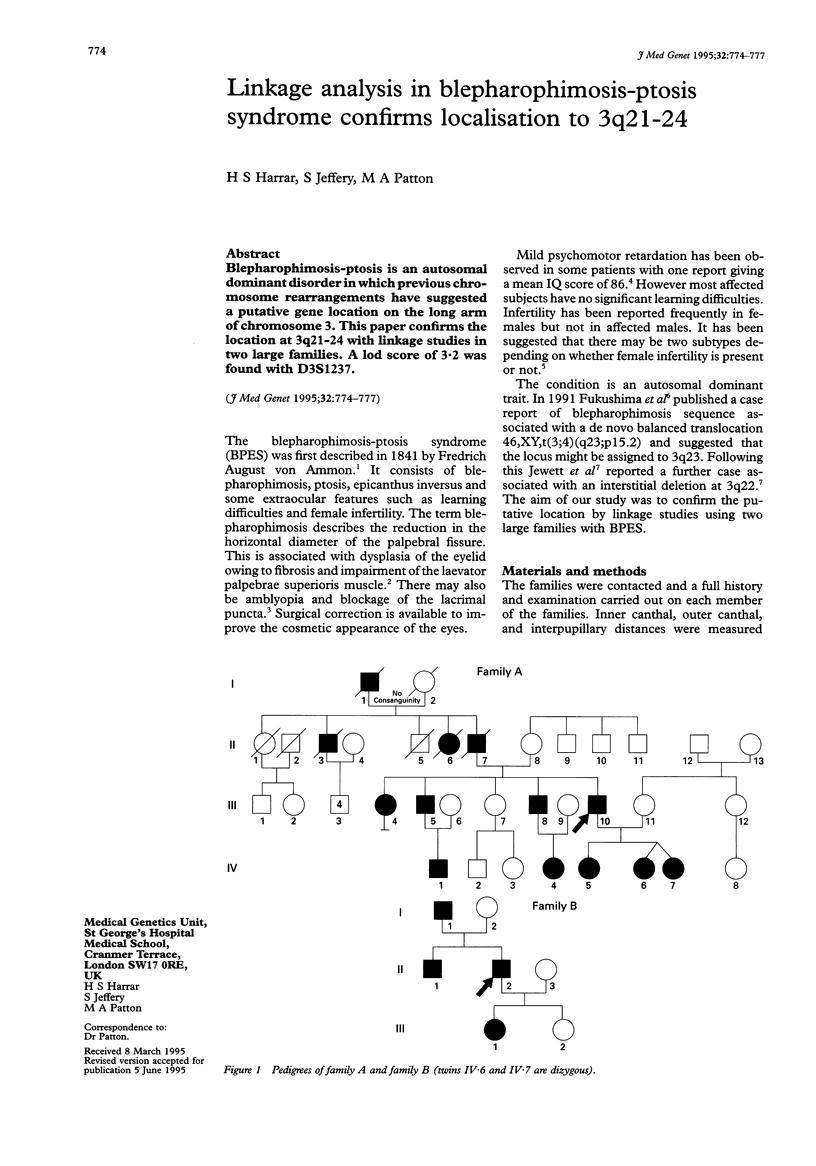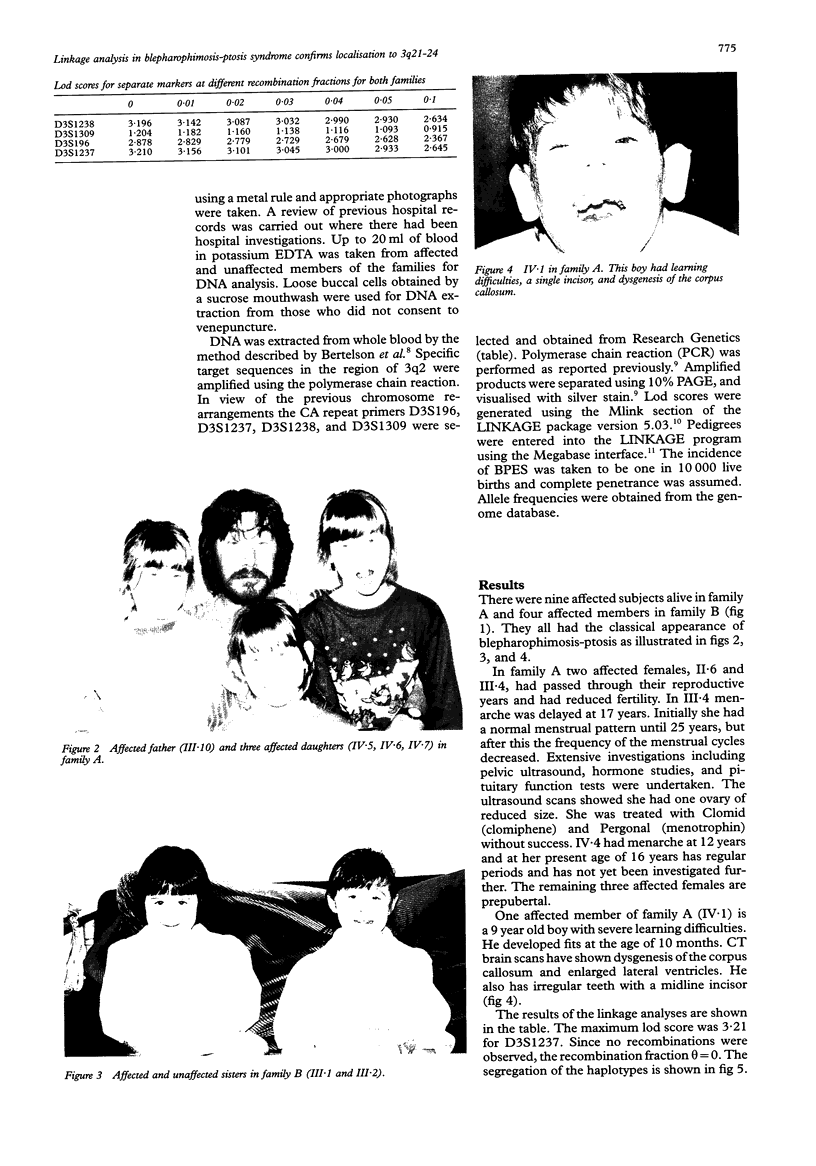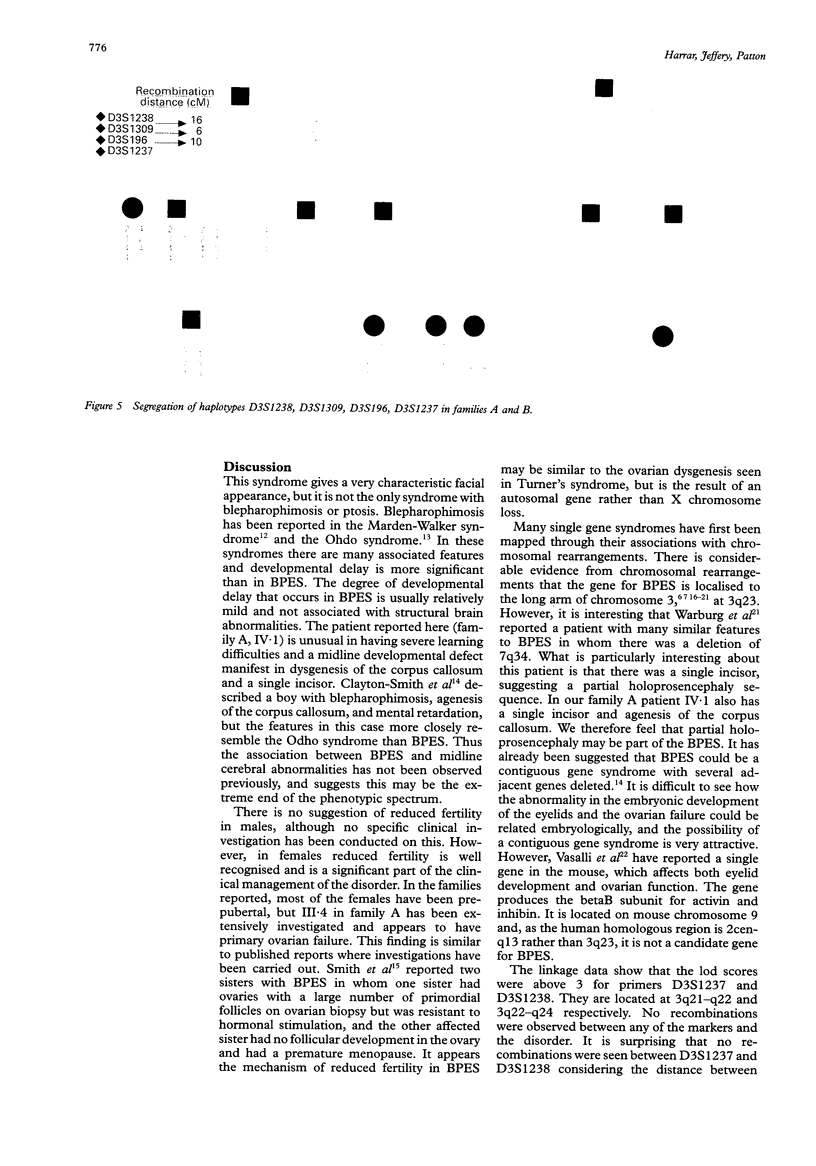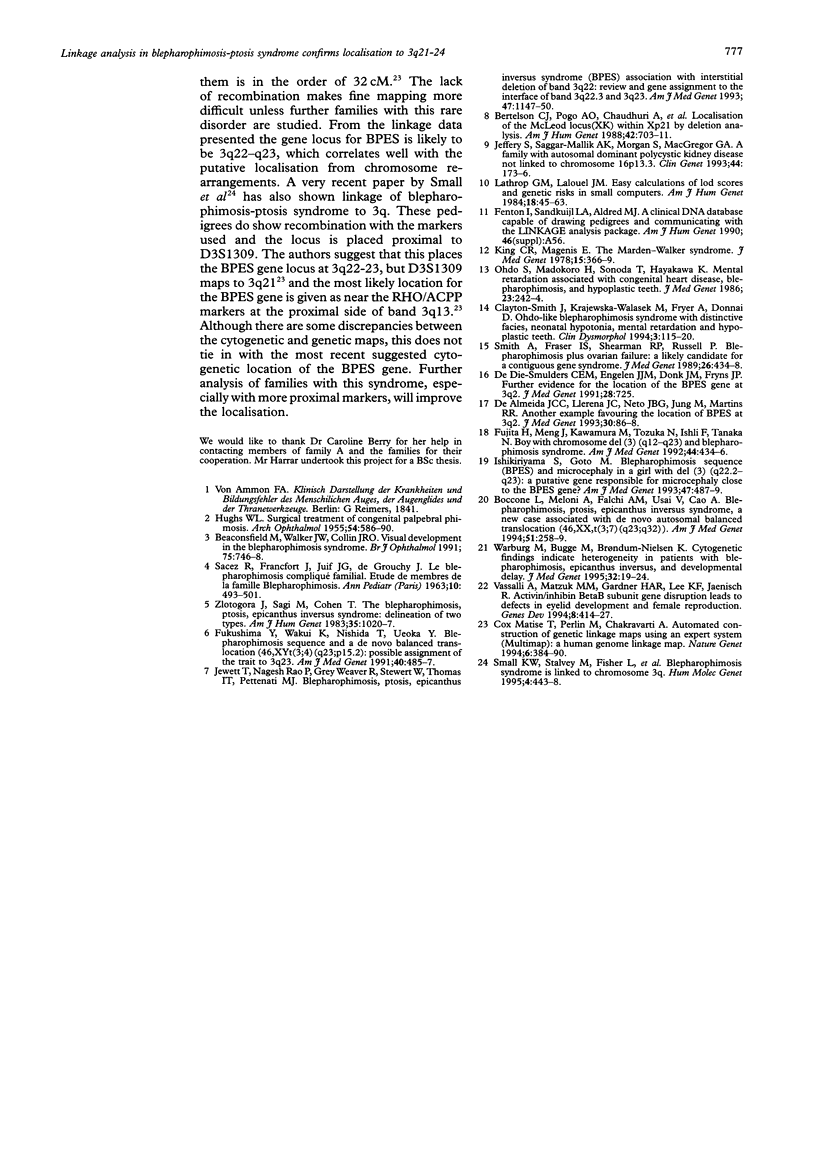Abstract
Blepharophimosis-ptosis is an autosomal dominant disorder in which previous chromosome rearrangements have suggested a putative gene location on the long arm of chromosome 3. This paper confirms the location at 3q21-24 with linkage studies in two large families. A lod score of 3·2 was found with D3S1237.
Full text
PDF



Images in this article
Selected References
These references are in PubMed. This may not be the complete list of references from this article.
- Beaconsfield M., Walker J. W., Collin J. R. Visual development in the blepharophimosis syndrome. Br J Ophthalmol. 1991 Dec;75(12):746–748. doi: 10.1136/bjo.75.12.746. [DOI] [PMC free article] [PubMed] [Google Scholar]
- Bertelson C. J., Pogo A. O., Chaudhuri A., Marsh W. L., Redman C. M., Banerjee D., Symmans W. A., Simon T., Frey D., Kunkel L. M. Localization of the McLeod locus (XK) within Xp21 by deletion analysis. Am J Hum Genet. 1988 May;42(5):703–711. [PMC free article] [PubMed] [Google Scholar]
- Boccone L., Meloni A., Falchi A. M., Usai V., Cao A. Blepharophimosis, ptosis, epicanthus inversus syndrome, a new case associated with de novo balanced autosomal translocation [46,XY,t(3;7)(q23;q32)]. Am J Med Genet. 1994 Jul 1;51(3):258–259. doi: 10.1002/ajmg.1320510317. [DOI] [PubMed] [Google Scholar]
- Clayton-Smith J., Krajewska-Walasek M., Fryer A., Donnai D. Ohdo-like blepharophimosis syndrome with distinctive facies, neonatal hypotonia, mental retardation and hypoplastic teeth. Clin Dysmorphol. 1994 Apr;3(2):115–120. [PubMed] [Google Scholar]
- Fujita H., Meng J., Kawamura M., Tozuka N., Ishii F., Tanaka N. Boy with a chromosome del (3)(q12q23) and blepharophimosis syndrome. Am J Med Genet. 1992 Nov 1;44(4):434–436. doi: 10.1002/ajmg.1320440409. [DOI] [PubMed] [Google Scholar]
- Fukushima Y., Wakui K., Nishida T., Ueoka Y. Blepharophimosis sequence and de novo balanced autosomal translocation [46,XY,t(3;4)(q23;p15.2)]: possible assignment of the trait to 3q23. Am J Med Genet. 1991 Sep 15;40(4):485–487. doi: 10.1002/ajmg.1320400423. [DOI] [PubMed] [Google Scholar]
- HUGHES W. L. Surgical treatment of congenital palpebral phimosis; the Y-V operation. AMA Arch Ophthalmol. 1955 Oct;54(4):586–590. doi: 10.1001/archopht.1955.00930020592012. [DOI] [PubMed] [Google Scholar]
- Ishikiriyama S., Goto M. Blepharophimosis sequence (BPES) and microcephaly in a girl with del(3) (q22.2q23): a putative gene responsible for microcephaly close to the BPES gene? Am J Med Genet. 1993 Sep 15;47(4):487–489. doi: 10.1002/ajmg.1320470411. [DOI] [PubMed] [Google Scholar]
- Jeffery S., Saggar-Malik A. K., Morgan S., MacGregor G. A. A family with autosomal dominant polycystic kidney disease not linked to chromosome 16p13.3. Clin Genet. 1993 Oct;44(4):173–176. doi: 10.1111/j.1399-0004.1993.tb03874.x. [DOI] [PubMed] [Google Scholar]
- Jewett T., Rao P. N., Weaver R. G., Stewart W., Thomas I. T., Pettenati M. J. Blepharophimosis, ptosis, and epicanthus inversus syndrome (BPES) associated with interstitial deletion of band 3q22: review and gene assignment to the interface of band 3q22.3 and 3q23. Am J Med Genet. 1993 Dec 1;47(8):1147–1150. doi: 10.1002/ajmg.1320470802. [DOI] [PubMed] [Google Scholar]
- King C. R., Magenis E. The Marden-Walker syndrome. J Med Genet. 1978 Oct;15(5):366–369. doi: 10.1136/jmg.15.5.366. [DOI] [PMC free article] [PubMed] [Google Scholar]
- Matise T. C., Perlin M., Chakravarti A. Automated construction of genetic linkage maps using an expert system (MultiMap): a human genome linkage map. Nat Genet. 1994 Apr;6(4):384–390. doi: 10.1038/ng0494-384. [DOI] [PubMed] [Google Scholar]
- Ohdo S., Madokoro H., Sonoda T., Hayakawa K. Mental retardation associated with congenital heart disease, blepharophimosis, blepharoptosis, and hypoplastic teeth. J Med Genet. 1986 Jun;23(3):242–244. doi: 10.1136/jmg.23.3.242. [DOI] [PMC free article] [PubMed] [Google Scholar]
- SACREZ R., FRANCFORT J., JUIF J. G., DE GROUCHY J. LE BL'EPHAROPHIMOSIS COMPLIQU'E FAMILIAL. ETUDE DES MEMBRES DE LA FAMILLE BLE. Ann Pediatr (Paris) 1963 Oct 2;10:493–501. [PubMed] [Google Scholar]
- Small K. W., Stalvey M., Fisher L., Mullen L., Dickel C., Beadles K., Reimer R., Lessner A., Lewis K., Pericak-Vance M. A. Blepharophimosis syndrome is linked to chromosome 3q. Hum Mol Genet. 1995 Mar;4(3):443–448. doi: 10.1093/hmg/4.3.443. [DOI] [PubMed] [Google Scholar]
- Smith A., Fraser I. S., Shearman R. P., Russell P. Blepharophimosis plus ovarian failure: a likely candidate for a contiguous gene syndrome. J Med Genet. 1989 Jul;26(7):434–438. doi: 10.1136/jmg.26.7.434. [DOI] [PMC free article] [PubMed] [Google Scholar]
- Vassalli A., Matzuk M. M., Gardner H. A., Lee K. F., Jaenisch R. Activin/inhibin beta B subunit gene disruption leads to defects in eyelid development and female reproduction. Genes Dev. 1994 Feb 15;8(4):414–427. doi: 10.1101/gad.8.4.414. [DOI] [PubMed] [Google Scholar]
- Warburg M., Bugge M., Brøndum-Nielsen K. Cytogenetic findings indicate heterogeneity in patients with blepharophimosis, epicanthus inversus, and developmental delay. J Med Genet. 1995 Jan;32(1):19–24. doi: 10.1136/jmg.32.1.19. [DOI] [PMC free article] [PubMed] [Google Scholar]
- Zlotogora J., Sagi M., Cohen T. The blepharophimosis, ptosis, and epicanthus inversus syndrome: delineation of two types. Am J Hum Genet. 1983 Sep;35(5):1020–1027. [PMC free article] [PubMed] [Google Scholar]






